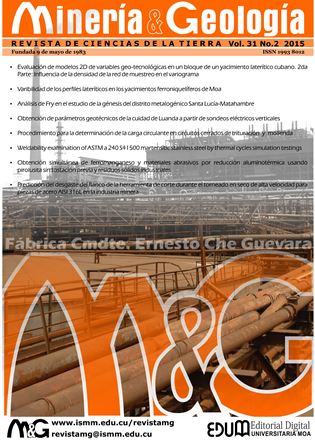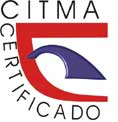Prediction of flank wear of the cutting tool during dry high-speed turning for steel parts AISI 316L in the mining industry
Keywords:
High speed turning, flank wear, AISI 316L, experimental study, analysis of variance and regressionAbstract
In this research an experimental study of the influence of cutting parameters in turning of AISI 316L stainless steel with coated inserts of TiCN, Al2O3, TiN was performed. A scanning electron microscope was used to measure and analyze the wear of the cutting tools. Results were compared using analysis of variance and multiple regression for describing the relation between the flank wear of the cutting tools, machining time and the cutting feed, obtaining the equations adjusted models. The research demonstrated the significant effect of feed and machining time in flank wear. The three coating layers insert did not exceed the criterion of end of life of wear while the insert with one layer suffered a catastrophic wear at the highest cutting speed. The flank wear showed the best performance for the cutting feed of 0,08 mm/rev at all the speeds used in the study.Downloads
References
ASILTÜRK, I. & ÇUNKA, M. 2011: Modeling and prediction of surface roughness in turning operations using artificial neural network and multiple regression method. Expert Systems with Applications 38(5): 5 826–5 832.
BARTARYA, G. & CHOUDHURY, S. K. 2012: State of the art in hard turning. International Journal of Machine Tools and Manufacture 53(1): 1-14.
CIFTCI, I. 2006: Machining of austenitic stainless steels using CVD multi-layer coated cemented carbide tools. Tribology International 39(6): 565-569.
CORDES, S. E. 2012: Thermal stability of γ-alumina PVD coatings and analysis of their performance in machining of austenitic stainless steels. CIRP Journal of Manufacturing Science and Technology 5(1): 20-25.
GAITONDE, V.; KARNIK, S.; SIDDESWARAPPA, B. & ACHYUTHA, B. 2008: Integrating Box-Behnken design with genetic algorithm to determine the optimal parametric combination for minimizing burr size in drilling of AISI 316L stainless steel. The International Journal of Advanced Manufacturing Technology 37(3): 230-240.
GALANIS, N. & MANOLAKOS, D. 2010: Surface roughness prediction in turning of femoral head. The International Journal of Advanced Manufacturing Technology 51(1): 79-86.
GERTH, J.; GUSTAVSSON, F.; COLLIN, M.; ANDERSSON, G.; NORDH, L. G.; HEINRICHS, J. & WIKLUND, U. 2014: Adhesion phenomena in the secondary shear zone in turning of austenitic stainless steel and carbon steel. Journal of Materials Processing Technology 214(8): 1 467-1 481.
HERNÁNDEZ, L. W.; PÉREZ, R.; ZAMBRANO, P.; GUERRERO, M. & DUMITRESCU, P. 2011: Estudio del desgaste del flanco de carburos recubiertos y cermet durante el torneado de alta velocidad en seco del acero AISI 1045. Revista de Metalurgia 47(3): 262-272.
JIANXIN, D.; JIANTOU, Z.; HUI, Z. & PEI, Y. 2011: Wear mechanisms of cemented carbide tools in dry cutting of precipitation hardening semi-austenitic stainless steels. Wear 270(7–8): 520-527.
JIAO, Y.; LEI, S.; PEI, Z. J. & LEE, E. S. 2004: Fuzzy adaptive networks in machining process modeling: surface roughness prediction for turning operations. International Journal of Machine Tools & Manufacture 44(15): 1 643–1 651.
KORKUT, I.; KASAP, M.; CIFTCI, I. & SEKER, U. 2004: Determination of optimum cutting parameters during machining of AISI 304 austenitic stainless steel. Materials & Design 25(4): 303-305.
LASTRES, M.; CORDOVÉS, A. & ARZOLA, J. 2010: Distribución y corte de piezas irregulares con anidamiento bidimensional en la industria minera. Minería y Geología 26(3): 48-67.
LEPPERT, T. & PENG, R. 2012: Residual stresses in surface layer after dry and MQL turning of AISI 316L steel. Production Engineering 6(4): 367-374.
LIN, H. M. 2008: The study of high speed fine turning of austenitic stainless steel. Journal of Achievements in Materials and Manufacturing Engineering 27(2): 191-194.
MAHDAVINEJAD, R. & SAEEDY, S. 2011: Investigation of the influential parameters of machining of AISI 304 stainless steel. Sadhana 36(6): 963-970.
NAVES, V. T. G.; DA SILVA, M. B. & DA SILVA, F. J. 2013: Evaluation of the effect of application of cutting fluid at high pressure on tool wear during turning operation of AISI 316 austenitic stainless steel. Wear 302(1–2): 1 201-1 208.
SURESH, R.; BASAVARAJAPPA, S.; GAITONDE, V. N. & SAMUEL, G. L. 2012: Machinability investigations on hardened AISI 4340 steel using coated carbide insert. International Journal of Refractory Metals and Hard Materials 33: 75-86.
SURESH, R.; BASAVARAJAPPA, S. & SAMUEL, G. L. 2012: Some studies on hard turning of AISI 4340 steel using multilayer coated carbide tool. Measurement 45(7): 1 872-1 884.
XAVIOR, M. A. & ADITHAN, M. 2009: Determining the influence of cutting fluids on tool wear and surface roughness during turning of AISI 304 austenitic stainless steel. Journal of Materials Processing Technology 209(2): 900-909.
Published
How to Cite
Issue
Section
- Authors retain copyright and guaranteeing the right magazine to be the first publication of the work as licensed under a Creative Commons Attribution-NonCommercial that allows others to share the work with an acknowledgment of the work's authorship and initial publication in this journal.
- Authors may establish separate supplemental agreements for the exclusive distribution version of the work published in the journal (eg, place it in an institutional repository or publish it in a book), with an acknowledgment of its initial publication in this journal.
- Authors are allowed and recommended to disseminate their work through the Internet (e.g., in institutional telematic archives or on their websites) before and during the submission process, which can produce interesting exchanges and increase citations of the published work. (See The effect of open access)










